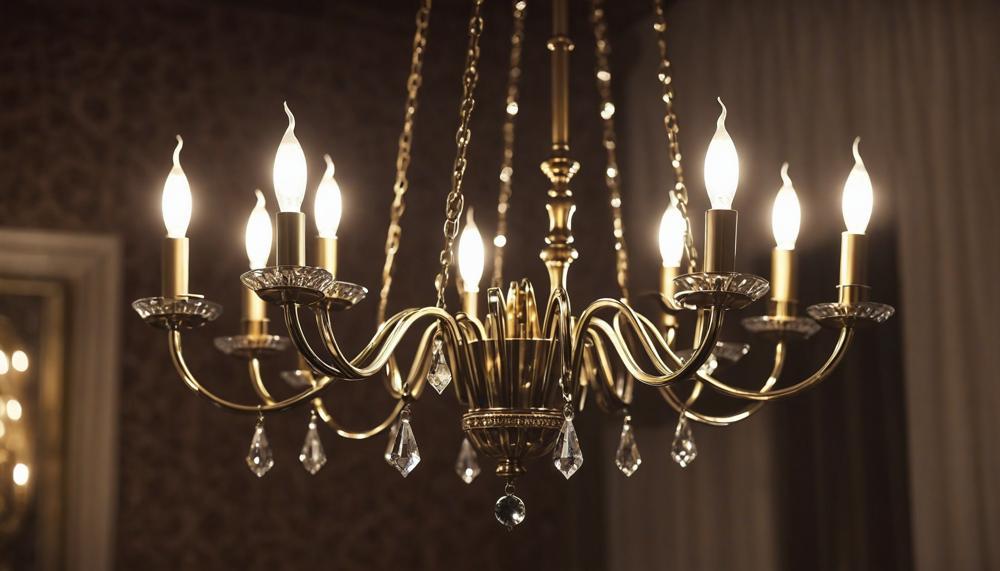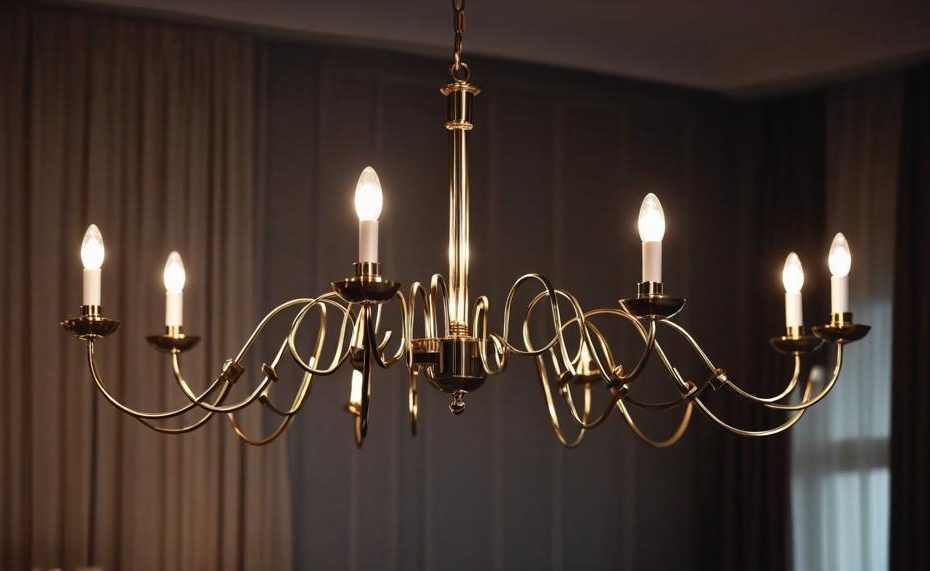Shortening a chandelier rod might seem tricky at first, but it’s actually a straightforward DIY project that can significantly enhance the look of your space.
Whether you’re trying to adjust the height to better fit your room or simply making a design tweak, mastering this task is both practical and satisfying. Let’s dive right into the essentials:

- Measure with Precision: Start by determining the exact length you need. Use a measuring tape and mark the desired cut point on the rod.
- Cutting the Rod: Equip yourself with wire cutters or a hacksaw to make a clean, even cut at your marked point.
- Ensure Safety: After making your adjustments, turn the power back on to verify that everything is functioning correctly. Safety first.
- Final Adjustments: If the rod still isn’t the right length, consider purchasing a new one or using extension kits available at home improvement stores.
- Proper Tensioning: Make sure to adjust the tensioner properly to keep the rod securely in place without over-tightening.
By following these steps, you can achieve the perfect chandelier height, ensuring your lighting not only looks great but functions optimally.
Stay tuned as we guide you through each step in detail, ensuring your chandelier transformation is seamless and successful.
Step 1
To shorten a chandelier rod, you will need several tools and materials. Here’s a detailed list to guide you through the process:
| Tool | Purpose | Details |
| Measuring Tape | Measure the rod length | Accurately determine how much of the rod needs to be removed. |
| Marker | Mark the cutting point | Mark the exact spot where you will cut the rod. |
| Wire Cutter or Hacksaw | Cut the rod | Use a wire cutter for thinner rods or a hacksaw for thicker rods to make a clean cut at the marked point. |
| Pliers | Handle and adjust the rod | Use pliers to hold and adjust the rod while cutting and smoothing edges. |
| Metal File and Sandpaper | Smooth rough edges | After cutting, file down any jagged edges and smooth them with sandpaper to avoid sharp edges. |
| Nuts and Bolts or Nails | Secure the shortened rod | Use nuts and bolts or nails to securely attach the rod to the chandelier. |
Process Overview:
- Measure and Mark: Use a measuring tape to determine the desired length of the rod and mark it clearly with a marker.
- Cut the Rod: Carefully cut the rod at the marked point using a wire cutter for thin rods or a hacksaw for thicker rods.
- Smooth Edges: Use a metal file to remove any burrs and sandpaper to smooth the cut edges, ensuring there are no sharp points.
- Secure the Rod: Reattach the shortened rod to the chandelier using nuts and bolts or nails, ensuring it is securely fastened.
Step 2
To shorten a chandelier rod, you need specific tools and materials to ensure the process is safe and efficient. Here’s a detailed list:
| Tools | Materials | Purpose |
| Measuring Tape or Ruler | To measure the desired length of the rod. | |
| Pipe Cutter or Hacksaw | To cut the rod to the required length. | |
| Metal File or Sandpaper | To smooth the cut edges of the rod. | |
| Pliers | To bend and adjust the rod ends if necessary. | |
| Drill with Metal Bit | To drill new holes for wiring or mounting, if needed. | |
| Safety Glasses and Gloves | To protect yourself while cutting and handling the rod. | |
| Support Stand or Helper | To hold the chandelier securely during the process. | |
| Marker or Chalk | To mark the cut point on the rod. |
Explanation
- Measuring Tape or Ruler: Precision is crucial. Measure the exact length you want for your chandelier rod, ensuring a symmetrical and balanced look.
- Pipe Cutter or Hacksaw: Use these tools to make a clean cut. A pipe cutter provides a neater finish, but a hacksaw works well for thicker rods.
- Metal File or Sandpaper: After cutting, smooth the edges to prevent sharp burrs that can cause injuries or damage to the wiring.
- Pliers: Handy for bending or adjusting the rod ends, ensuring they fit back into the chandelier mount seamlessly.
- Drill with Metal Bit: If the rod needs new holes for wiring or attachment points, a drill is essential. Choose a bit size that matches your chandelier’s mounting hardware.
- Safety Gear: Protect your eyes from metal shavings and your hands from sharp edges. Always wear safety glasses and gloves during the cutting process.
- Support Stand or Helper: The chandelier should be held securely to avoid any accidental damage. A helper or a sturdy stand can provide the necessary support.
- Marker or Chalk: Clearly mark the cutting point to ensure an accurate cut, preventing any mistakes that could ruin the rod.
By using these tools and materials, you can successfully shorten your chandelier rod, ensuring a customized fit and a polished finish.
We Recommend
To effectively shorten a chandelier rod, certain tools and materials are indispensable. Below is a detailed guide to ensure you have everything you need for a smooth and safe process.
| Tool/Material | Description | Recommendations |
| Threaded or Unthreaded Rod | The main component to be shortened. Threaded rods have screw threads along their length; unthreaded rods do not. | Choose based on your chandelier’s design. |
| Measuring Tape | Accurate measurement is crucial for determining the new length of the rod. | Use a sturdy, reliable tape measure. |
| Pipe Cutter or Hacksaw | Used for cutting the rod to the desired length. A pipe cutter provides a cleaner cut, while a hacksaw is more versatile. | Opt for a high-quality pipe cutter for precision. |
| File | Essential for smoothing the cut edges of the rod to prevent injuries and ensure a proper fit. | A metal file with a comfortable grip works best. |
| Manufacturer’s Instructions | Guidelines specific to your chandelier model for reassembling the fixture correctly. | Always keep these handy for reference. |
| Electrical Wiring Management Tools | Tools like wire strippers, connectors, and electrical tape for safe wiring management. | Use insulated tools for safety. |
| Damp Cloth | For cleaning up any dust or debris generated during the cutting process. | A microfiber cloth is ideal for thorough cleaning. |
Steps to Shorten a Chandelier Rod:
- Measure and Mark: Use the measuring tape to determine the new length of the rod. Mark the spot with a pencil.
- Cut the Rod: For a threaded rod, use a pipe cutter to ensure a clean cut. For unthreaded rods, a hacksaw will suffice. Cut along the marked line.
- Smooth the Edges: Use a file to smooth any rough edges from the cut to avoid injury and ensure a proper fit.
- Reassemble the Fixture: Follow the manufacturer’s instructions to reattach the chandelier components.
- Manage Electrical Wiring: Use appropriate tools to handle the wiring safely. Ensure all connections are secure and insulated.
- Clean Up: Wipe down the rod and surrounding area with a damp cloth to remove any dust or metal shavings.
Step 3
To successfully shorten a chandelier rod, you need several essential tools and materials to ensure the job is done efficiently and safely. Here’s a comprehensive list of what you’ll need:
| Tool/Material | Purpose |
| Wire Cutters | Cutting chandelier wires |
| Pliers | Gripping, twisting, and bending wires |
| Ruler or Measuring Tape | Accurate measurement of rod length |
| Hacksaw | Cutting the metal rod |
| Bolt Cutters | Removing chain links |
| Replacement Crystals or Beads | Replacing decorative elements |
| Jump Rings | Attaching decorative elements |
| Gloves | Hand protection |
| Safety Glasses | Eye protection |
| Closed-Toe Shoes | Foot protection |
| Voltage Tester | Ensure power is off |
| Screwdrivers | Loosening and tightening screws |
| Electrical Tape | Securing wire connections |
| Ladder or Step Stool | Reaching the chandelier safely |
Step 4
To successfully shorten a chandelier rod, you’ll need a range of tools and materials to ensure a precise and safe process. Here’s a comprehensive list:
| Tool/Material | Description | Purpose |
| Measuring Tape | A flexible ruler used to measure the length of the rod accurately. | To measure the desired length of the chandelier rod. |
| Marker | A permanent marker or pen. | To mark the cutting point on the rod. |
| Wire Cutter | A tool designed to cut through wires and thin rods. | To cut the rod to the marked length. |
| Hacksaw (optional) | A fine-toothed saw used for cutting metal. | For cutting thicker or more robust rods that wire cutters can’t handle. |
| Nuts and Bolts or Nails | Fastening hardware. | To secure the rod, especially if it’s being cut into two pieces. |
| Metal File and Sandpaper | Tools for smoothing rough edges. | To smooth the cut edges of the rod, ensuring there are no sharp points. |
| Extension Kit | A kit containing extra rod segments. | For extending the rod if needed. |
| Safety Precautions | Gloves, goggles, and electrical safety guidelines. | To protect yourself while handling and cutting the rod and dealing with electrical components. |
| Professional Assistance | Electricians or handymen. | To help with complex electrical work or if you’re uncomfortable doing it yourself. |
| Additional Expenses | Cost of hiring professionals or buying extra materials. | Budget considerations for professional services and additional tools. |
Explanation:
- Measuring Tape and Marker: Ensuring accurate measurement and marking are vital to avoid mistakes that could compromise the chandelier’s balance.
- Wire Cutter and Hacksaw: Depending on the rod’s material and thickness, you may need different cutting tools.
- Nuts, Bolts, Nails: Necessary for securing the rod segments together if it’s cut into pieces.
- Metal File and Sandpaper: Essential for smoothing out rough or sharp edges post-cutting to prevent injury or damage.
- Extension Kit: Useful if, after shortening, you realize the rod needs to be lengthened again.
- Safety Precautions: Personal protective equipment and electrical safety measures are crucial for a safe modification process.
- Professional Assistance: It’s always wise to consult or hire a professional for tasks involving electrical components to avoid any hazardous situations.
These tools and materials will help you tackle the chandelier rod shortening project effectively, ensuring safety and precision in your DIY home improvement task.
Step 5
The key to measuring the desired length for your chandelier rod involves several crucial steps, ensuring your chandelier looks balanced and fits well within your space. Here’s how you can achieve the perfect length:
Determine Ceiling Height
Measure the height of your ceiling from floor to ceiling at the exact spot where you plan to install the chandelier. Most ceilings are 8-10 feet high, but accurate measurement is essential.
Consider Furniture and Table Heights
Measure the height of any furniture or tables directly below where the chandelier will hang. Ensure there is at least 30 inches (76 cm) between the bottom of the chandelier and the top of any furniture or table to prevent obstruction and provide ample space.
Calculate Rod Length
Use the following general guidelines:
- Above a Table: Hang the chandelier 30-36 inches (76-91 cm) above the table surface.
- Above the Floor (No Table): Hang the chandelier so it is at least 7 feet (213 cm) above the floor.
Adjust Based on Ceiling Height
For standard 8-foot ceilings, a rod length of 1-2 feet (30-61 cm) is typically ideal. Adjust this length for taller ceilings to maintain aesthetic balance and functionality.
Consider Chandelier Size and Style
- Larger, more elaborate chandeliers may require longer rods to ensure a proportional look.
- Simpler, smaller chandeliers may not need as much length.
Adjustable Height Feature
If your chandelier has an adjustable height feature, you can easily modify the rod length to your preferred measurement. For fixed rods, measure and cut the rod to the correct length using appropriate tools.
Conclusion
Shortening a chandelier rod can transform your space and tailor your lighting to fit perfectly. This seemingly intricate task is surprisingly straightforward with a bit of planning and the right tools.
Start by measuring the desired rod length with precision. Mark your cutting point using a marker, ensuring accuracy to avoid any missteps. Next, use wire cutters or a hacksaw to make a clean cut along the marked point. Remember, safety first: turn off the power before you start and wear protective gear.
After cutting, smooth the edges with a metal file and sandpaper to eliminate any sharp points. Reattach the shortened rod to the chandelier, securing it with nuts and bolts or nails. If the length isn’t quite right, consider purchasing a new rod or an extension kit from a home improvement store.
Adjust the tensioner to keep the rod securely in place without over-tightening. After reassembling, turn the power back on and test the fixture to ensure everything is functioning correctly. This careful attention to detail guarantees that your chandelier will not only look stunning but will also operate safely and efficiently.





